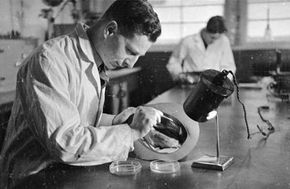Locard's Exchange Principle
Although Locard's exchange principle is generally understood as the phrase "with contact between two items, there will be an exchange," Edmond Locard never actually wrote down those words in the vast amount of material he produced, nor did he mention anything concerning a principle. Locard, however, did write the following:
"It is impossible for a criminal to act, especially considering the intensity of a crime, without leaving traces of this presence."
Advertisement
In other words, Locard believed that no matter where a criminal goes or what a criminal does, he will leave something at the scene of the crime. At the same time, he will also take something back with him. A criminal can leave all sorts of evidence, including fingerprints, footprints, hair, skin, blood, bodily fluids, pieces of clothing and more. By coming into contact with things at a crime scene, a criminal also takes part of that scene with him, whether it's dirt, hair or any other type of trace evidence.
Dr. Locard tested out this principle during many of his investigations. In 1912, for instance, a Frenchwoman named Marie Latelle was found dead in her parents' home. Her boyfriend at the time, Emile Gourbin, was questioned by police, but he claimed he had been playing cards with some friends the night of the murder. After the friends were questioned, Gourbin appeared to be telling the truth.
When Locard looked at the corpse, however, he was led to believe otherwise. He first examined Latelle's body and found clear evidence that she was strangled to death. He then scraped underneath Gourbin's fingernails for skin cell samples and later viewed the results underneath a microscope. Very soon, Locard noticed a pink dust among the samples, which he figured to be ladies makeup.
Although makeup was popular around the time of the murder, it was by no means mass produced, and this was reason enough for Locard to search a little further. He eventually located a chemist who developed a custom powder for Latelle, and a match was made. Gourbin confessed the murder -- he had tricked his friends into believing his alibi by setting the clock in the game room ahead. Locard's exchange principle had worked.
To learn more about the world of crime, forensic science and how to catch the bad guys, follow the links below.
Related HowStuffWorks Articles
More Great Links
Sources
- Bisbing, Richard. "Locard exchange." Modern Microscopy Journal. Jan. 29, 2004. http://www.modernmicroscopy.com/main.asp?article=11&print=true
- Chisum, W.J. Turvey, Brent. "Evidence dynamics: Locard's exchange principle and crime reconstruction." Journal of Behavioral Profiling. Vol. 1, no. 1. January 2000. http://www.profiling.org/journal/vol1_no1/jbp_ed_january2000_1-1.html
- Wagner, E.J. "The Science of Sherlock Holmes: from Baskerville Hall to the Valley of Fear, the real forensics behind the great detective's greatest cases." New Jersey: John Wiley & Sons, 2006.
